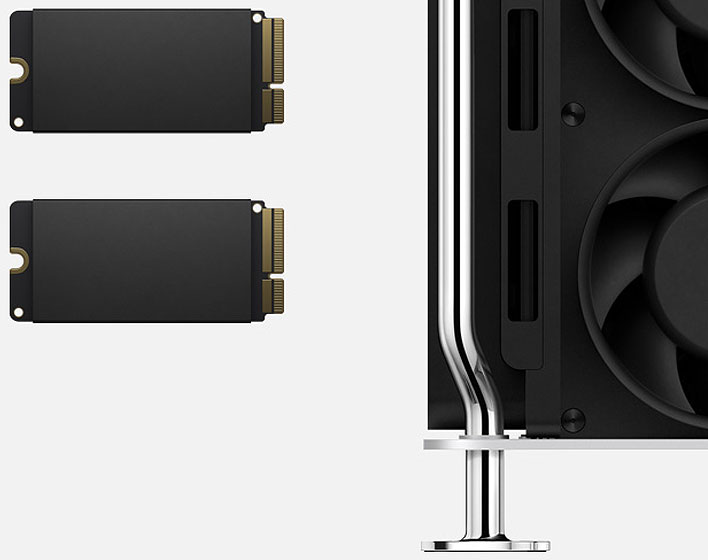Forget about the
Mac Pro's resemblance to a cheese grater and ignore the price tag for a moment. From a pure hardware standpoint,
Apple's latest iteration of the Mac Pro is an impressive collection of hardware, boasting an
Intel Xeon foundation with up to 28 cores and 56 threads, a dozen DIMM slots supporting up to 1.5TB of 2933MHz ECC memory, and the list goes on. The question is, how proprietary is the design?
We know that Apple is using MPX (Mac Pro Expansion) modules for the graphics, each of which has its own dedicated heatsink, further cooled by the Mac Pro's internal fans. Users have the option of installing a traditional GPU in one of the expansion slots, but without the module's benefits (noise control, cooling, Thunderbolt integration). There is also a
lack of support for NVIDIA GPUs.
It's not just the graphics that raises questions. Apple's stock rendering of a pair of SSD modules contains a different pin count and division than any standard SSD on the market. Take a look at the SSDs in Apple's render (above) and compare with
Western Digital's Black SN750 that we recently reviewed (below)...
Notice how the pin count is different between the two images, particularly on the left (and smaller) portion of the connector. The division between the two sections also sits closer to the middle in Apple's render, versus a standard M.2 SSD.
The render that Apple provided is not like any other connector that we know of, including an
Intel Optane memory module or
hybrid SSD. An mSATA connector is perhaps closest in design, but the pin count still differs, and the speed claims Apple makes with regards to storage seems to rule out an mSATA interface.
The eagle-eyed folks at Apple Insider who noticed the disparity between Apple's SSD renders and any standard SSD on the market spoke with sources inside Apple. They are not not authorized to speak on behalf of Apple, but noted that the pin count is indeed different than a standard M.2 layout. The sources wouldn't say if the pin layout is consistent with older Apple SSD modules, such as the ones found inside the 13-inch MacBook Pro (late 2016).
It's possible that the SSD renders are incorrect, though that seems unlikely—Apple is careful about what it does (and does not) show. If using Occam's razor to cut through the clues, the most likely explanation is that the storage is proprietary.
Apple also pointed out that the up to 4TB of SSD storage in the Mac Pro is encrypted by a T2 security chip. Combined with the modular nature of the Mac Pro, it seems Apple will be selling replacement/upgrade storage components. If that is the case, we will have to wait and see what kind of markup those drives carry.



